|
|
| Übersicht – Contents: | |
Diese Seite ist Teil des Projektes
|
|
| Übersicht – Contents: | |
Flaggen – Flags: |
|
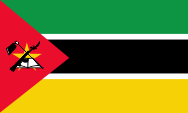 |
National-, Staats und Handelsflagge |
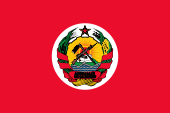 |
Flagge des Präsidenten |
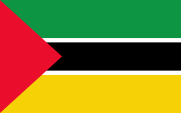 |
1962-1997, |
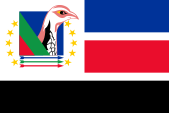 |
Flagge der Partei RENAMO |
historische Flaggen – historical Flags: |
|
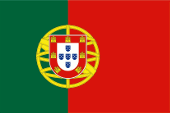 |
1911–1975, |
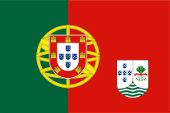 |
60-er Jahre 19. Jhd. / sixties of the 19th cent., |
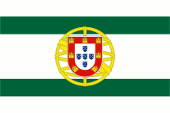 |
bis/to 1935, Flagge eines Oberkommissars – flag of a High Commissioner, Seitenverhältnis – ratio = 2:3, Quelle/Source, nach by: Flaggenbuch 1939 |
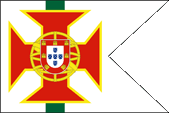 |
1935–1961, Flagge eines Distriktskommandanten – flag of a District Commandant, Seitenverhältnis – ratio = 2:3, Quelle/Source, nach by: Flaggenbuch 1939 |
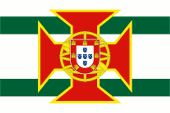 |
1935–1975, Flagge des Generalgouverneurs – flag of the Governor General, Seitenverhältnis – ratio = 2:3, Quelle/Source, nach by: Die Welt im bunten Flaggenbild  |
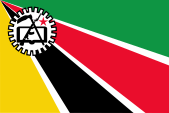 |
1975–1983, |
| Die heutige Flagge von Mosambik wurde am 01.05.1983 eingeführt. Sie zeigt drei waagerechte Streifen in Grün, Schwarz und Gelb mit schmalen weißen Trennstreifen dazwischen. Am Liek ein gleichschenkliges rotes Dreieck mit einer vereinfachten Version des Staatswappens von Mosambik darin. Dieses Emblem besteht aus Hacke und Kalaschnikow-MP (AK-47), die sich kreuzen, sowie einem aufgeschlagenen Buch. Im Hintergrund ein gelber fünfzackiger Stern. | The
today's flag of Mozambique was introduced on 1st of May in 1983. It shows
three horizontal stripes in green, black and yellow with slender white
separating stripes among them. On the leech an isosceles red triangle with a
simplified version of the coat of arms of Mozambique in it. That emblem consists of hoe and Kalashnikov-MPi (AK-47), crossing themselves, as well as a opened book. In the background a yellow five-pointed star. |
| Die Farben der Flagge scheinen heute folgendermaßen definiert zu sein, und zwar: Grün = Pantone 355, Rot = Pantone 185 und Gelb = Pantone 116. Die Farbe Grün steht für den fruchtbaren Boden, Rot für den Freiheitskampf, Schwarz für den afrikanischen Kontinent, und Gelb für die Bodenschätze des Landes. | The
colours of the flag seem to be defined today as follows: green = Pantone
355, red = Pantone 185 and yellow = Pantone 116. The colour green stands for the fertile soil, red for the struggle for freedom, black for the African continent and yellow for the mineral resources of the country. |
| Die Flagge von Mosambik basiert auf der Flagge der FRELIMO-Bewegung (Frente de Libertaçao de Moçambique). Diese durfte bereits ein Jahr vor der Unabhängigkeit neben der portugiesischen Flagge gehisst werden. Bei der Schaffung der Flagge der FRELIMO stand wiederum die Flagge des südafrikanischen ANC Modell. So zeigte die FRELIMO-Flagge die ANC-Farben Grün, Schwarz und Gelb, dazu weiße schmale Trennstreifen und ein rotes Dreieck am Mast. | The flag of Mozambique is based on the flag of the FRELIMO-Movement (Frente de Libertaçao de Moçambique). That flag was allowed to hoist already one year before the independence beside the Portugese flag. For the creation of the flag of the FRELIMO was the pattern the flag of the South African ANC. In this way the the FRELIMO flag showed the colours of the ANC green, black and yellow, with them white slender separating stripes and a red triangle on the pole. |
| Die für das unabhängige Mosambik am 25.06.1975 eingeführte Flagge zeigte zwar ebenfalls diese Farben, jedoch in einer anderen Anordnung und mit einer vereinfachten Version des Wappens. Im Jahr 1983 soll kurzzeitig – für nur ein oder zwei Tage – eine auf dem Modell Flagge der FRELIMO basierende Flagge als Nationalflagge verwendet worden sein. Sie zeigte das Emblem der Flagge von 1975 vor einem großen gelben fünfzackigen Stern in dem roten Dreieck am Liek. | The for
the independent Mozambique on 25th of June in 1975 introduced flag showed
indeed as well that colours however in an other arrangement and with a
simplified version of the coat of arms. In the year 1983 should momentary – for only one or two days – has been in use an on the model of the flag of the FRELIMO basing flag as national flag. It showed the emblem of the flag of 1975 in front of a large yellow five-pointed star in the red triangle on the leech. |
| In der Zeit als portugiesische Kolonie wurde ausschließlich die portugiesische Nationalflagge verwendet, da man die Kolonien als fester Bestandteil des Mutterlandes betrachtete, und nicht als Außenbesitzungen. Das bedeutete, das portugiesische Kolonien nie eigene Flaggen hatten, auch wenn es in den sechziger Jahren des 20. Jahrhunderts Bestrebungen gab Flaggen für die Kolonien einzuführen, indem man das Wappen der Kolonie in das fliegende Ende der portugiesischen Nationalflagge platzierte. Diese Pläne wurden jedoch nie realisiert. | In the
times of the Portugese colony was solely in use the Portugese national flag
because they saw the colonies as permanent component of the motherland and
not as outer possessions. This implys that Portugese
colonies never had own flags, even if there were ambitions in the sixties of
the 20th century to introduce flags for the colonies by placing of the coat
of arms of the colony in the flying end of the Portugese national flag. But
this plans became never realized. |
| Im Jahre 1935 wurden für die portugiesischen Kolonien eigene Wappen eigeführt. Die Gestaltung unterlag einem gewissen Schema und so zeigte jedes Wappen neben einer lokalen Symbolik die fünf Quinas aus dem Wappen von Portugal und fünf grüne Wellen auf Silber. Als lokale Symbolik erschienen im Wappen von Portugiesisch-Ostafrika ein Pfeilbündel und ein Joch. | In the year 1935 own coats of arms were created for the Portuguese colonies. The design was subject to a special scheme. So each coat of arms contained, in addition to a local symbolism, the five Quinas from the coat of arms of Portugal and five green waves on silver. As the local symbolism in the coat of arms of Portuguese East Africa a bundle of arrows and a yoke. |
| Quelle/Source: Flags of the World, World Statesmen, Volker Preuß | |
Wappen – Coat of Arms: |
|
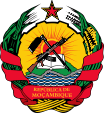 |
Wappen von Mosambik – coat of arms of Mozambique Quelle/Source: Jam123, CC0, via Wikimedia Commons |
 |
1935–1975, Wappen von Portugiesisch-Ostafrika – coat of arms of Portuguese East Africa, Quelle/Source: nach/by: Wikipedia (D) |
| Das Staatswappen von Mosambik besteht in der heutigen Form seit dem September 1982 und zeigt vor dem Hintergrund eines gelben Zahnrads (Sinnbild der Industrialisierung) im unteren Teil des Wappens blaue Wellenlinien (Ozean) und eine grüne Landkarte des Landes. Darauf ein Buch (Sinnbild der Bildung), die aufgehende Sonne (Sinnbild des Neuanfangs) eine Hacke und eine Kalaschnikow-MP (AK-47), die sich kreuzen. Sie symbolisieren den Bauernstand und die wachsame Verteidigungsbereitschaft des Landes. Der gelbgeränderte rote Stern steht für die Unabhängigkeit und die politische Ausrichtung des Staates, den Sozialismus. Auf dem roten Band im unteren Teil des Wappens steht der Name des Landes in Portugiesisch. Das Wappen wurde in Details mehrfach abgeändert. | The coat
of arms of Mozambique exists in the today's form since September 1982 and
shows in front of the background of a yellow sprocket (allegory of
industrialization) in the lower part of the coat of arms blue wave lines
(ocean) and a green map of the country. Thereupon a book (allegory of literacy), the rising sun (allegory of a new start) a how and a Kalashnikov-MPi (AK-47) crossing themselves. They symbolize the farmer's staus and the vigilant readiness for defense of the country. The yellow bordered red star stands for the independence and the political orientation of the state, the socialism. On the red banner in the lower part of the coat of arms the name of the country in Portugese. Details of the coat of arms have been changed several times. |
| Im Jahre 1935 wurden für die portugiesischen Kolonien eigene Wappen eigeführt. Die Gestaltung unterlag einem gewissen Schema und so zeigte jedes Wappen neben einer lokalen Symbolik die fünf Quinas aus dem Wappen von Portugal und fünf grüne Wellen auf Silber. Als lokale Symbolik erschienen im Wappen von Portugiesisch-Ostafrika ein Pfeilbündel und ein Joch. | In the
year 1935 own coats of arms were created for the Portuguese colonies. The
design was subject to a special scheme. So each coat of arms contained, in addition to a local symbolism, the five Quinas from the coat of arms of Portugal and five green waves on silver. As the local symbolism in the coat of arms of Portuguese East Africa a bundle of arrows and a yoke. |
| Quelle/Source: Flaggen Wappen Hymnen, Flaggen und Wappen der Welt, Wikipedia (D), Volker Preuß | |
Flugzeugkokarde – aircraft roundel: |
|
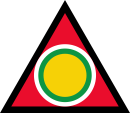 |
seit/since 2011, Flugzeugkokarde – aircraft roundel, Quelle/Source, nach/by: Wikipedia (EN) |
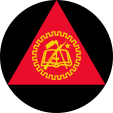 |
1975–2011, Flugzeugkokarde – aircraft roundel, Quelle/Source, nach/by: Wikipedia (EN) |
|
|
|
Landkarte – Map: |
Lage – Position: |
Landkarte des Landes – Map of the Country: |
|
|
| Zahlen und Fakten – Numbers and Facts: | |
|
|
|
|
|
|
|
|
|
|
|
|
|
|
|
|
|
|
| 10./11.
Jhd. · Araber gründen an der Küste die Handelsstützpunkte Quelimane, Sena
und Sofala 14./15. Jhd. · Teile des heutigen Mosambik südlich des Sambesi gehören zum Reich Monomotapa (Simbabwe) 1498 · der portugiesische Seefahrer Vasco da Gama entdeckt und landet an der Küste des heutigen Mosambik 1505–1507 · Portugal erobert die arabischen Handelsstützpunkte und fast die gesamte ostafrikanische Küste bis nach Mogadischu (Somalia), in der Folgezeit lassen sich portugiesische Siedler vor allem am Sambesi nieder und erschließen das Land dem Flusslauf folgend, die Kolonie wird von Goa (Indien) aus verwaltet 1544 · Portugal besetzt die Delagoa-Bucht 17. Jhd. · Portugal kann im Süden des Landes sein Einflussgebiet vorübergehend auf die Territorien des zerfallenden Reiches Monomotapa ausdehnen, im Norden erreicht Portugal das Westufer des Malawisees 1604–1658 · die Niederlande gefährden die portugiesischen Besitzungen 1721–1730 · die Niederlande besetzen die Delagoa-Bucht 1752 · verwaltungsmäßige Trennung von Goa 1869 · Grenzvertrag mit dem Burenstaat Transvaal regelt den Grenzverlauf im Süden 1875 · Gründung von Lourenço Marques in der Delagoa-Bucht 1880 · Portugal verzichtet zugunsten Großbritanniens auf Teile seiner Einflussgebiete (Rhodesien, Malawi) 1885 · die Berliner Kongokonferenz bestätigt die portugiesischen Besitzungen in Portugiesisch-Ostafrika 1891 · Grenzvertrag mit Großbritannien regelt den Grenzverlauf zu Rhodesien und Malawi 1896 · Grenzvertrag mit dem Deutschen Reich regelt den Grenzverlauf zu Deutsch-Ostafrika 1920 · Angliederung des Kionga-Dreiecks an der Mündung des Flusses Rovuma (Teil von Deutsch-Ostafrika) 1951 · Portugiesisch-Ostafrika wird Überseeprovinz Portugals 1962 · Gründung der FRELIMO-Befreiungsbewegung in Tanganjika 1964 · Beginn des Guerillakampfes der FRELIMO, Teilerfolge im Norden des Landes 25.06.1975 · Unabhängigkeit, Proklamation der Volksrepublik Mosambik, Mosambik wird ein marxistischer Einparteienstaat unter der FRELIMO-Partei 1984 · Beginn des Guerillakampfes der RENAMO, Teilerfolge im Norden und Westen des Landes 1989 · Demokratisierung 1990 · neue Verfassung, Umbenennung in Republik Mosambik 1992 · Friedensabkommen zwischen RENAMO und FRELIMO 1994 · Wahlen, Sieg der FRELIMO 2000 · Unruhen von RENAMO-Anhängern 2013–2019 · Kämpfe zwischen RENAMO und FRELIMO 2019 · Friedensabkommen zwischen RENAMO und FRELIMO |
| 10th/11th
cent. · Arabs stablish on the coast the trade stations Quelimane, Sena and
Sofala 14th/15th cent. · parts of the today's Mozambique southern the Zambezi River belong to the Empire of Monomotapa (Simbabwe) 1498 · the Portugese seafarer Vasco da Gama discoveres and debarks on the coast of the today's Mozambique 1505–1507 · Portugal conquers the Arab trade stations and nearly the whole east African coast to Mogadishu (Somalia), in the afteryears settle Portugese colonists especially near the Zambezi River and develop the country following the course of the river, the colony becomes administrated from Goa (India) 1544 · Portugal occupies the Delagoa Bay 17th cent. · Portugal is able to expand its area of influence in the south of the country momentary at the territories of the decaying Empire of Monomotapa, in the north Portugal reaches the western bank of the Malawi Sea 1604–1658 · the Netherlands endanger the Portugese possessions 1721–1730 · the Netherlands occupie the Delagoa Bay 1752 · administrative separation from Goa 1869 · border treaty with the Boer State of Transvaal determines the borderline in the south 1875 · foundation of Lourenço Marques in the Delagoa Bay 1880 · Portugal disclaims to favor of Great Britain for parts of its areas of influence (Rhodesia, Malawi) 1885 · the Berlin Congo Conference confirms the Portugese possessions in Portugese East Afrika 1891 · border treaty with Great Britain determines the borderline to Rhodesia and Malawi 1896 · border treaty with the German Empire determines the borderline to German East Africa 1920 · annexation of the Kionga Triangle on the mouth of the Rovuma River (part of German East Africa) 1951 · Portugese East Africa becomes an overseas province of Portugal 1962 · foundation of the FRELIMO liberation movement in Tanganjika 1964 · beginning of the Guerilla fight of the FRELIMO, partial success in the north of the country 25th of June 1975 · independence, proclamation of the People’s Republic of Mozambique, Mozambique becomes a marxistic single-party-state under the FRELIMO-Party 1984 · beginning of the Guerilla fight of the RENAMO, partial success in the north and in the west of the country 1989 · democratization 1990 · new constituion, rename in Republic of Mozambique 1992 · peace agreement between RENAMO and FRELIMO 1994 · elections, victory of the FRELIMO 2000 · riots of RENAMO supporters 2013–2019 · battles between RENAMO and FRELIMO 2019 · peace agreement between RENAMO and FRELIMO |
| Quelle/Source: Atlas zur Geschichte, World Statesmen, Discovery '97, Wikipedia (D) |
| Der Name "Mosambik" geht auf den Namen der Stadt "Moçambique" im Norden des Landes zurück. Möglicherweise hat man sich als Landesnamen für den Namen Moçambique entschieden, weil diese Stadt in der Geschichte als Handelsplatz eine große Bedeutung hatte. | The name "Mozambique" has its roots in the name of the town "Moçambique" in the north of the country. Maybe that they decided for the name Moçambique as name of the country because this town had in the past a large importance as trade place. |
| Quelle/Source: Volker Preuß | |